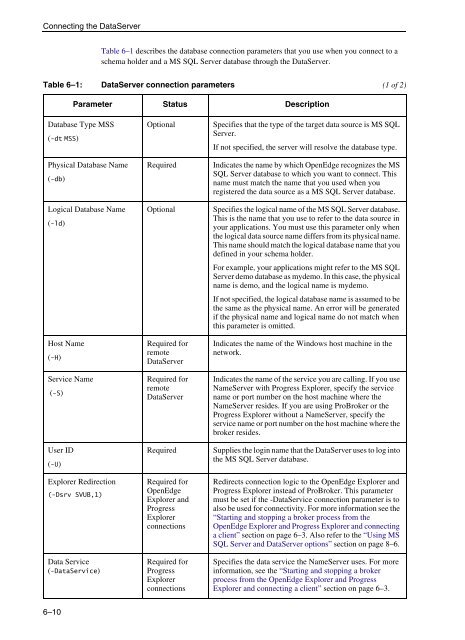OpenEdge Data Management: DataServer for Microsoft SQL Server
OpenEdge Data Management: DataServer for Microsoft SQL Server
OpenEdge Data Management: DataServer for Microsoft SQL Server
You also want an ePaper? Increase the reach of your titles
YUMPU automatically turns print PDFs into web optimized ePapers that Google loves.
Connecting the <strong>Data</strong><strong>Server</strong><br />
6–10<br />
Table 6–1 describes the database connection parameters that you use when you connect to a<br />
schema holder and a MS <strong>SQL</strong> <strong>Server</strong> database through the <strong>Data</strong><strong>Server</strong>.<br />
Table 6–1: <strong>Data</strong><strong>Server</strong> connection parameters (1 of 2)<br />
Parameter Status Description<br />
<strong>Data</strong>base Type MSS<br />
(-dt MSS)<br />
Physical <strong>Data</strong>base Name<br />
(-db)<br />
Logical <strong>Data</strong>base Name<br />
(-ld)<br />
Host Name<br />
(-H)<br />
Service Name<br />
(-S)<br />
User ID<br />
(-U)<br />
Explorer Redirection<br />
(-Dsrv SVUB,1)<br />
<strong>Data</strong> Service<br />
(-<strong>Data</strong>Service)<br />
Optional Specifies that the type of the target data source is MS <strong>SQL</strong><br />
<strong>Server</strong>.<br />
If not specified, the server will resolve the database type.<br />
Required Indicates the name by which <strong>OpenEdge</strong> recognizes the MS<br />
<strong>SQL</strong> <strong>Server</strong> database to which you want to connect. This<br />
name must match the name that you used when you<br />
registered the data source as a MS <strong>SQL</strong> <strong>Server</strong> database.<br />
Optional Specifies the logical name of the MS <strong>SQL</strong> <strong>Server</strong> database.<br />
This is the name that you use to refer to the data source in<br />
your applications. You must use this parameter only when<br />
the logical data source name differs from its physical name.<br />
This name should match the logical database name that you<br />
defined in your schema holder.<br />
For example, your applications might refer to the MS <strong>SQL</strong><br />
<strong>Server</strong> demo database as mydemo. In this case, the physical<br />
name is demo, and the logical name is mydemo.<br />
If not specified, the logical database name is assumed to be<br />
the same as the physical name. An error will be generated<br />
if the physical name and logical name do not match when<br />
this parameter is omitted.<br />
Required <strong>for</strong><br />
remote<br />
<strong>Data</strong><strong>Server</strong><br />
Required <strong>for</strong><br />
remote<br />
<strong>Data</strong><strong>Server</strong><br />
Indicates the name of the Windows host machine in the<br />
network.<br />
Indicates the name of the service you are calling. If you use<br />
Name<strong>Server</strong> with Progress Explorer, specify the service<br />
name or port number on the host machine where the<br />
Name<strong>Server</strong> resides. If you are using ProBroker or the<br />
Progress Explorer without a Name<strong>Server</strong>, specify the<br />
service name or port number on the host machine where the<br />
broker resides.<br />
Required Supplies the login name that the <strong>Data</strong><strong>Server</strong> uses to log into<br />
the MS <strong>SQL</strong> <strong>Server</strong> database.<br />
Required <strong>for</strong><br />
<strong>OpenEdge</strong><br />
Explorer and<br />
Progress<br />
Explorer<br />
connections<br />
Required <strong>for</strong><br />
Progress<br />
Explorer<br />
connections<br />
Redirects connection logic to the <strong>OpenEdge</strong> Explorer and<br />
Progress Explorer instead of ProBroker. This parameter<br />
must be set if the -<strong>Data</strong>Service connection parameter is to<br />
also be used <strong>for</strong> connectivity. For more in<strong>for</strong>mation see the<br />
“Starting and stopping a broker process from the<br />
<strong>OpenEdge</strong> Explorer and Progress Explorer and connecting<br />
a client” section on page 6–3. Also refer to the “Using MS<br />
<strong>SQL</strong> <strong>Server</strong> and <strong>Data</strong><strong>Server</strong> options” section on page 8–6.<br />
Specifies the data service the Name<strong>Server</strong> uses. For more<br />
in<strong>for</strong>mation, see the “Starting and stopping a broker<br />
process from the <strong>OpenEdge</strong> Explorer and Progress<br />
Explorer and connecting a client” section on page 6–3.

















